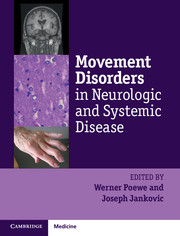Book contents
- Frontmatter
- Contents
- List of contributors
- List of videos
- List of abbreviations
- Preface
- Section I General principles
- Chapter 1 Phenomenology, classification, and diagnostic approach to patients with movement disorders
- Chapter 2 Pathogenesis of movement disorders: basic neuroanatomy and pathophysiology
- Chapter 3 Principles of management in movement disorders
- Section II Movement disorders in systemic disease
- Section III Iatrogenic and toxic movement disorders
- Section IV Movement disorders in general neurology
- Section V Systemic complications of movement disorders
- Index
- Plate Section
- References
Chapter 2 - Pathogenesis of movement disorders: basic neuroanatomy and pathophysiology
from Section I - General principles
Published online by Cambridge University Press: 05 April 2014
- Frontmatter
- Contents
- List of contributors
- List of videos
- List of abbreviations
- Preface
- Section I General principles
- Chapter 1 Phenomenology, classification, and diagnostic approach to patients with movement disorders
- Chapter 2 Pathogenesis of movement disorders: basic neuroanatomy and pathophysiology
- Chapter 3 Principles of management in movement disorders
- Section II Movement disorders in systemic disease
- Section III Iatrogenic and toxic movement disorders
- Section IV Movement disorders in general neurology
- Section V Systemic complications of movement disorders
- Index
- Plate Section
- References
Summary
Introduction
Movement disorders are conditions affecting the ability to produce and control voluntary as well as involuntary movements and comprise a large group of diseases with a wide range of different etiologies and very diverse clinical presentations. For many of the conditions, the pathophysiology remains unclear or at least partially unknown. Some of the more common and “classical” movement disorders, such as Parkinson’s disease and Huntington’s disease, arise from disturbances of the basal ganglia. Hence, movement disorders are sometimes also referred to as basal ganglia disorders.
There is visible evidence of anatomical changes in the basal ganglia in many movement disorders, such as degeneration of the caudate nucleus in Huntington’s disease, or degeneration of the substantia nigra in Parkinson’s disease (Tretiakoff 1919). Damage to these specific anatomical structures due to causes other than the idiopathic disease such as infectious disease, vascular changes, or tumors is known to cause symptoms which can resemble, for example, Parkinson’s disease or the chorea in Huntington’s disease. For many other movement disorders such as idiopathic dystonia or DYT-1-positive dystonia, no such gross anatomical alterations have been found, but (secondary) dystonic syndromes occur in patients with lesions of the putamen, globus pallidus, caudate nucleus, as well as the thalamus and other structures outside the basal ganglia. Several lines of evidence suggest that at least some movement disorders are likely to result from malfunction outside the basal ganglia, such as cortical motor areas, cerebellum, or brainstem and pontine motor centers. For some entities such as psychogenic movement disorders or some forms of idiopathic late onset dystonia, the pathophysiology remains largely unknown.
Information
- Type
- Chapter
- Information
- Movement Disorders in Neurologic and Systemic Disease , pp. 16 - 30Publisher: Cambridge University PressPrint publication year: 2014
